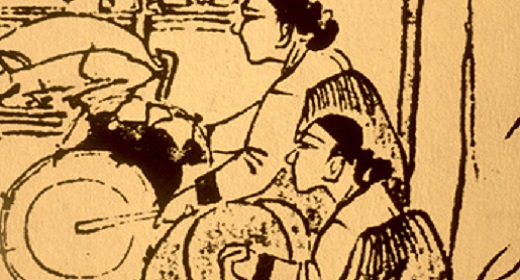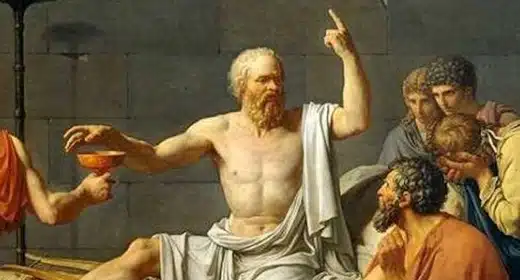“The safest general characterization of the European philosophical tradition is that it consists of a series of footnotes to Plato.”
 by Alfred North Whitehead: The Republic’ is one of the foundational writings of Western philosophy and civilization. We see Platonic thought and Socratic methodology still vitally evolving in today’s world. Dialectic questioning is the basis of Marxism and many other schools of philosophy. Indeed, the question-and-answer method plays an expansive role in our legal, scientific and educational systems. Moreover, Plato’s views concerning the nature of humankind – his notion of “mind over matter” in the individual soul – is a cornerstone of Christianity. The arguments and ideas of The Republic have had a profound influence on all the dialectic swings within our social, political, and religious quests and thinking since they were first written down in Athens twenty-five hundred years ago.
by Alfred North Whitehead: The Republic’ is one of the foundational writings of Western philosophy and civilization. We see Platonic thought and Socratic methodology still vitally evolving in today’s world. Dialectic questioning is the basis of Marxism and many other schools of philosophy. Indeed, the question-and-answer method plays an expansive role in our legal, scientific and educational systems. Moreover, Plato’s views concerning the nature of humankind – his notion of “mind over matter” in the individual soul – is a cornerstone of Christianity. The arguments and ideas of The Republic have had a profound influence on all the dialectic swings within our social, political, and religious quests and thinking since they were first written down in Athens twenty-five hundred years ago.
Plato (Greek: Pláton) (c. 427 BC – c. 347 BC) was an immensely influential classical Greek philosopher, student of Socrates, teacher of Aristotle, writer, and founder of the Academy in Athens.
Plato, a philodorian, lectured extensively at the Academy but he also wrote on many philosophical issues. His presence survives through his written philosophical/dramatic compositions which are preserved in manuscripts recovered and edited in many different editions and translations since the birth of the Humanist movement. The written corpus of Plato consists almost entirely of dialogues, epigrams and letters. All the known dialogues of Plato survive, however modern-day standard editions of his oeuvre generally contain dialogues considered by the consensus of scholars to be either suspect (e.g., Alcibiades, Clitophon) or probably spurious (such as Demodocus, or the Second Alcibiades).
The personage of Socrates often makes an appearance in the dialogues of Plato though it is unclear how much of the content and argument of any given dialogue is Socrates’ point of view, and how much of it Plato’s.
“The safest general characterization of the European philosophical tradition is that it consists of a series of footnotes to Plato.”
Alfred North Whitehead, Process and Reality, 1929
Biography
Plato was born in Athens, into a moderately well-to-do aristocratic family. His father was named Ariston and his mother Perictione. One of Plato’s ancestors, Glaucon, was one of the best-known members of the Athenian nobility. Plato’s own real name was “Aristocles” however his nickname, Plato, originated from wrestling circles. Since Plato means “broad,” it probably refers either to his physical appearance or to his wrestling stance or style.
Plato became a pupil of Socrates in his youth, and — at least according to his personal account — he attended his master’s trial, though not his execution. Unlike Socrates, Plato wrote down his philosophical views and left a considerable number of manuscripts (see below). He was deeply affected by the city’s treatment of Socrates and much of his early work records his memories of his teacher. It is suggested that much of his ethical writing is in pursuit of a society where similar injustices could not occur.
Plato was also deeply influenced by the Pythagoreans, whose notions of numerical harmony have clear echoes in Plato’s notion of the Forms (sometimes thus capitalized; see below); by Anaxagoras, who taught Socrates and who held that the mind or reason pervades everything; and by Parmenides, who argued the unity of all things and was perhaps influential in Plato’s conception of the Soul.
Plato founded one of the earliest known organized schools in Western civilization when he was 40 years old on a plot of land in the Grove of Academe. The Academy was “a large enclosure of ground which was once the property of a citizen at Athens named Academus… some however say that it received its name from an ancient hero.” (Robinson, Arch. Graec. I i 16) and it operated until it was closed by Justinian I of Byzantium in AD 529. Many intellectuals were schooled here, the most prominent being Aristotle.
In Plato’s writings one finds debates concerning aristocratic and democratic forms of government. One finds debates concerning the role of heredity and environment in human intelligence and personality long before the modern “nature versus nurture” debate began in the time of Hobbes and Locke, with its modern continuation in such controversial works as The Mismeasure of Man and The Bell Curve. One finds arguments for the subjectivity — and objectivity — of human knowledge which foreshadow modern debates between Hume and Kant, or between the postmodernists and their opponents. Even the story of the lost city or continent of Atlantis came to us as an illustrative story told by Plato in his Timaeus and Critias.
Work
Plato wrote mainly in the form of dialogues. In the early ones several characters discuss a topic by asking questions of one another. Socrates figures prominently and a lively, more disorganized form of elenchos/dialectic is perceived; these are called the Socratic Dialogues.
But the qualities of the dialogues changed a great deal over the course of Plato’s life. It is generally agreed that Plato’s earlier works are more closely based on Socrates’ thoughts, whereas his later writing increasingly breaks away from the views of his former teacher. In the middle dialogues, Socrates becomes a mouthpiece for Plato’s own philosophy, and the question-and-answer style is more pro forma: the main figure represents Plato and the minor characters have little to say except “yes”; “of course” and “very true”. The later dialogues read more like treatises, and Socrates is often absent or quiet. It is assumed that the later dialogues were written entirely by Plato, while some of the early dialogues could be transcripts of Socrates’ own dialogues. The question which, if any, of the dialogues are truly socratic is called the Socratic problem.
The ostensible mise-en-scene of a dialogue distances both Plato and a given reader from the philosophy being discussed; one can choose between at least two options of perception: either to participate in the dialogues, in the ideas being discussed, or choose to see the content as expressive of the personalities contained within the work.
The dialogue format also allows Plato to put unpopular opinions in the mouth of unsympathetic characters, e.g. Thrasymachus in The Republic.
Plato’s Metaphysics: Platonism, or realism
One of Plato’s legacies, and perhaps his greatest, was his dualistic metaphysics, often called (in metaphysics) Platonism or (Exaggerated) Realism. Plato’s metaphysics divides the world into two distinct aspects: the intelligible world of “forms” and the perceptual world we see around us. He saw the perceptual world, and the things in it, as imperfect copies of the intelligible forms or ideas. These forms are unchangeable and perfect, and are only comprehensible by the use of the intellect or understanding (i.e., a capacity of the mind that does not include sense-perception or imagination).This division can be found before Plato in Zoroaster (6th BC) philosophy which is called Minu (intelligence) and Giti (perceptual) worlds, as well as the concept of an ideal state which is Zoroaster called it Shahrivar (an ideal city).
In the Republic Books VI and VII, Plato used a number of metaphors to explain his metaphysical views: the metaphor of the sun, the well-known allegory of the cave, and most explicitly, the divided line. Taken together, these metaphors convey a complex and, in places, difficult theory: there is something called The Form of the Good (often interpreted as Plato’s God), which is the ultimate object of knowledge and which as it were sheds light on all the other forms (i.e., universals: abstract kinds and attributes) and from which all other forms “emanate.” The Form of the Good does this in somewhat the same way as the sun sheds light on or makes visible and “generates” things in the perceptual world. (See Plato’s metaphor of the sun.) In the perceptual world the particular objects we see around us bear only a dim resemblance to the more ultimately real forms of Plato’s intelligible world: it is as if we are seeing shadows of cut-out shapes on the walls of a cave, which are mere representations of the reality outside the cave, illuminated by the sun. (See Plato’s allegory of the cave.) We can imagine everything in the universe represented on a line of increasing reality; it is divided once in the middle, and then once again in each of the resulting parts. The first division represents that between the intelligible and the perceptual worlds. Then there is a corresponding division in each of these worlds: the segment representing the perceptual world is divided into segments representing “real things” on the one hand, and shadows, reflections, and representations on the other. Similarly, the segment representing the intelligible world is divided into segments representing first principles and most general forms, on the one hand, and more derivative, “reflected” forms, on the other. (See the divided line of Plato.) The form of government derived from this philosophy turns out to be one of a rigidly fixed hierarchy of hereditary classes, in which the arts are mostly suppressed for the good of the state, the size of the city and its social classes is determined by mathematical formula, and eugenic measures are applied secretly by rigging the lotteries in which the right to reproduce is allocated. The tightness of connection of such government to the lofty and original philosophy in the book has been debated.
Plato’s metaphysics, and particularly the dualism between the intelligible and the perceptual, would inspire later Neoplatonic thinkers (see Plotinus and Gnosticism) and other metaphysical realists. For more on Platonic realism in general, see Platonic realism and the Forms.
Plato also had some influential opinions on the nature of knowledge and learning which he propounded in the Meno, which began with the question of whether virtue can be taught, and proceeded to expound the concepts of recollection, learning as the discovery of pre-existing knowledge, and right opinion, opinions which are correct but have no clear justification (see Platonic epistemology).
A short history of Plato scholarship
Plato’s thought is often compared with that of his best and most famous student, Aristotle, whose reputation during the western Middle Ages so completely eclipsed that of Plato that the Scholastic philosophers referred to Aristotle as “the Philosopher.” Contrarily, in the Byzantine Empire the study of Plato continued.
One of the characteristics of the Middle Ages was reliance on authority and on scholastic commentaries on writings of Plato and other historically important philosophers, rather than accessing their original works. In fact, Plato’s original writings were essentially lost to western civilization until their reintroduction in the twelfth century through the Persian and Arab scholars. These scholars not only maintained the original Greek texts of the ancients, but expanded them by writing extensive commentaries and interpretations on Plato’s and Aristotle’s works (see Al-Farabi, Avicenna, Averroes). These were eventually translated into Latin and later into the local vernacular.
Only in the Renaissance, with the general resurgence of interest in classical civilization, did knowledge of Plato’s philosophy become more widespread again in the West. Many of the greatest early modern scientists and artists who broke with Scholasticism and fostered the flowering of the Renaissance, with the support of the Plato-inspired Lorenzo de Medici, saw Plato’s philosophy as the basis for progress in the arts and sciences. By the 19th century Plato’s reputation was restored and at least on par with Aristotle’s.
Notable Western philosophers have continued to examine Plato’s work since that time, diverging from traditional academic approaches with their own philosophy as a basis. Nietzsche attacked Plato’s moral and political theories, Heidegger expounded on Plato’s obfuscation of Being, and Karl Popper in The Open Society and Its Enemies (1945), argued that Plato’s proposal for a government system in the dialogue The Republic was prototypically totalitarian. While many critics reject such readings on a variety of grounds, they remain widely discussed.
Bibliography
Below is a list of works by Plato, marked (1) if scholars don’t generally agree that Plato is the author, and (2) if scholars generally agree that Plato is not the author of the work. Most of the works are widely available in paperback, either individually or in collections and anthologies. The works are traditionally arranged according to tetralogies ascribed to an ancient scholar and court astrologer to Tiberius named Thrasyllus by Diogenes Laertius.
| I. II. III. IV. V VI VII VIII IX |
Euthyphro, Apology, Crito, Phaedo Cratylus, Theaetetus, Sophist, Statesman Parmenides, Philebus, Symposium, Phaedrus First Alcibiades (1), Second Alcibiades (2), Hipparchus (2), Rival Lovers (2) Theages (2), Charmides, Laches, Lysis Euthydemus, Protagoras, Gorgias, Meno Greater Hippias (1), Lesser Hippias, Ion, Menexenus Clitophon (1), Republic, Timaeus, Critias Minos (2), Laws, Epinomis (2), Letters ((1) for some) |
The remaining works were transmitted under Plato’s name, but were considered spurious in antiquity:
Axiochus (2), Definitions (2), Demodocus (2), Epigrams (Plato), Eryxias (2), Halcyon (2), On Justice (2), On Virtue (2), Sisyphus (2)
The most complete translations of Plato’s extant works into English, still in print, are
Oxford University Press publishes scholarly editions of Plato’s Greek texts in the Oxford Classical Texts series, and some translations in the Clarendon Plato Series. The hardbound series Loeb Classical Library, published by Harvard University Press, publishes Plato’s extant works in Greek, with English translations on facing pages. Their volumes are listed below:
Volume II. Laches. Protagoras. Meno. Euthydemus ISBN 0-674-99183-4
Volume III. Lysis. Symposium. Gorgias ISBN 0-674-99184-2
Volume IV. Cratylus. Parmenides. Greater Hippias. Lesser Hippias ISBN 0-674-99185-0
Volume V. The Republic, Books 1-5 ISBN 0-674-99262-8
Volume VI. The Republic, Books 6-10 ISBN 0-674-99304-7
Volume VII. Theaetetus. Sophist ISBN 0-674-99137-0
Volume VIII. Statesman. Philebus. Ion ISBN 0-674-99182-6
Volume IX. Timaeus. Critias. Cleitophon. Menexenus. Epistles ISBN 0-674-99257-1
Volume X. Laws, Books 1-6 ISBN 0-674-99206-7
Volume XI. Laws, Books 7-12 ISBN 0-674-99211-3
Volume XII. Charmides. Alcibiades 1 & 2. Hipparchus. The Lovers. Theages. Minos. Epinomis ISBN 0-674-99221-0
Platonic idealism is the theory that the substantive reality around us is only a reflection of a higher truth. That truth, Plato argues, is the abstraction. A particular tree, with a branch or two missing, possibly alive, possibly dead, and initials of two lovers carved into its bark, is distinct from the form of Tree-ness. A Tree is the ideal that each of us holds that allows us to identify the imperfect reflections of trees all around us.
Some people construe “Platonism” to mean the proposition that universals exist independently of particulars (a universal is anything that can be predicated of a particular).
Platonism is an ancient school of philosophy, founded by Plato; this school had an actual, physical existence at a site just outside the walls of Athens called the Academy as well as the intellectual unity of a shared approach to philosophizing.
Platonism is generally divided into three periods:
2.Middle Platonism
3.Neoplatonism
Platonism is considered to be, in mathematics departments the world over, the predominant philosophy of mathematics, especially regarding the foundations of mathematics.
One statement of this philosophy is the thesis that mathematics is not created but discovered in some undescribed realm. A lucid statement of this is found in an essay written by the British mathematician G. H. Hardy in defense of pure mathematics.
The absence in this thesis of clear distinction between mathematical and nonmathematical “creation” leaves open the inference that it applies to allegedly creative endeavors in art, music, and literature.
Nietzsche was highly critical of Plato and his influence on Western philosophical thought.
Neoplatonism (also Neo-Platonism) is an ancient school of philosophy beginning in the 3rd century A.D. It was based on the teachings of Plato and Platonists; but it interpreted Plato in many new ways, such that Neoplatonism was quite different from what Plato taught, though not many Neoplatonists would admit the distinction.
Neoplatonism began with the philosopher Plotinus, though Plotinus claimed to have received his teachings from Ammonius Saccas, an illiterate dock-worker in Alexandria. Plotinus’s most important work was the Six Enneads, in which he explains his philosophy.
Plotinus taught the existence of an indescribable One, which emanated the rest of the universe as a sequence of lesser beings. Later Neoplatonic philosophers, especially Iamblichus, added hundreds of intermediate gods and beings as emanations between the One and humanity; but Plotinus’ system was much simpler in comparison.
Later neoplatonic philosophers included Porphyry, Proclus, Iamblichus and Hypatia of Alexandria.
Neoplatonism was frequently used as a philosophical foundation for paganism, and as a means of defending paganism against Christianity; but many Christians were also influenced by Neoplatonism. In Christian versions of Neoplatonism, the One is identified as God. Most important of these was Pseudo-Dionysius the Areopagite, whose work was very influential in the Middle Ages. Augustine of Hippo converted to Christianity under the influence of Plotinus, leading most scholars to label Augustine a frank Neoplatonist; although, they note that Augustine’s subordination of philosophy to scripture leads to striking differences from the non-Christian philosophy. Some scholars have shown that Neoplatonism was also influenced by Christian theology, notably through the belief systems known as Gnosticism.
Neoplatonism was revived in the Italian Renaissance by figures such as Marsilio Ficino.
D: Plato’s Republic: from Wikipedia.
The Republic is perhaps Plato’s best-known dialogue and one of his most influential. In it, he explains, through the character of Socrates, the fundamentals of his political philosophy (presented, stylistically, via the concept of a Utopia), his ethics, and his theory of universals (the ‘forms’)—among other things. The work is also famous for its literary style: the text is presented as a discussion between Socrates and several other students at a dinner.
The nominal goal of the Republic is to define justice. Given the difficulty of this task, Socrates and his interlocutors are lead into a discussion of justice in the state, which they see as the same as justice in the person, but on a grander (and therefore easier to discuss) scale. Because of this, some critics (such as Julia Annas) interpret Plato’s ideal of a just state as an allegory for the ideal of the just person.
The title “Republic” is derived from the Latin title given to the work by Cicero. Plato’s Greek language title, Politeia, described the government of a Polis or city-state. The character Socrates and his friends discuss the nature of an ideal city rather than the nature of the Athenian democracy.
The Republic bears little resemblance to the type of state that we, in modern times, know as a republic. Plato rejected democracy and used “The Republic” to criticize it for its alleged flaws, such as susceptibility to demagogues, rule by unfit “barbarians” etc. The concepts of democracy and of Utopia as depicted in The Republic are tied to the city-states of ancient Greece and their relevance to modern states is questionable.
Justice is defined as a state where everyone is to do their own work while not interfering with the work of others. This conception of justice, striking to the modern reader, is closely linked to the Greek conception of fate or necessity, such as that embodied later in Aristotle’s final cause. This definition of justice leads to a social structure radically different from most previous and subsequent states.
The ideal city as depicted in The Republic should be governed by philosopher-kings; disinterested persons who are to rule not for their personal enjoyment but for the good of the City-State. Socrates points out the human tendency to corruption by power and thus tyranny; therefore ruling should only be left to a certain class of people whose only purpose is to govern in what is deemed a just manner, and who are somehow immune to corruption. At this point, it is clear that the Platonic society is to be highly hierarchical. In addition to the ruling class of philosopher-kings, there is also to be a military class, and a lower class of the common people.
There are a number of provisions to avoid making the people weak: among those, censorship of certain kinds of music, poetry and theatre, a rigid education system, and the abolishment of riches. These apply to all three classes, and the restrictions placed on the philosopher-kings and the warriors are much more severe than those placed on the common workers, because the rulers must be kept away from any source of corruption. In addition, being both an educator as a parent and a worker is incompatible with the definition of justice. This leads to the abandonment of the typical family, and as such no child may know his or her parents and the parents may not know their own children. The rulers assemble couples for reproduction, based on breeding criteria. Education is thereafter relegated to specialized caregivers. Thus, stable population is achieved through eugenism and social cohesion is high because familiar links are extended towards everyone in the City. Social classes are largely static although marginal permeability is allowed.
The city of The Republic has struck many modern critics as unduly harsh, rigid, and unfree; indeed, as a kind of prequel to modern totalitarianism. Karl Popper is perhaps today’s best-known supporter of that view, which is the view generally represented in modern introductory college textbooks on political philosophy.
At the time Karl Popper wrote his critique, in 1945, and certainly among many political philosophers today, Plato was and is usually seen in a much more favorable light, for example by Hans-Georg Gadamer in his 1934 classic, Plato und die Dichter (and several other works), where the city of the Politeia is seen as a heuristic utopia that should not be pursued or even be used as an orientation-point for political development. Rather, its purpose is said to be to show how things would have to be connected, and how one thing would lead to another—often with highly problematic results—if one would opt for certain principles and carry them through rigorously. This interpretation argues that large passages in Plato’s writing are ironic (which, of course, an unusually high level of proficiency in ancient Greek is required to detect). Hence, Plato’s entire oeuvre would be much less totalitarian.
One of the most convincing arguments against this interpretation is that Plato’s academy has produced a number of tyrants, despite being well-versed in Greek and having direct contact with Plato himself. Among his direct students were Klearchos, tyrant of Heraklia, Chairon, tyrant of Pellene, Eurostatos and Choriskos, tyrants of Skepsis, Hermias, tyrant of Atarneos and Assos, and Kallipos, tyrant of Syracuse. Against this, however, it can be argued, first, that the question is whether these men became “tyrants” through studying in the Academy, and, second, that it is by no means obvious that they were tyrants in the modern, or any totalitarian, sense.
The Republic introduces Plato’s metaphysics in addition to politics and ethics. His theory of forms or ideals concerning the nature of reality is set forth, including the famous allegory of the cave, where the world around us is likened to the shadows cast onto the wall of a cave.
According to Platonic realism, universals exist in a “realm” (often so called) that is separate from space and time; one might say that universals have a sort of ghostly or heavenly mode of existence, but, at least in more modern versions of Platonism, such a description is probably more misleading than helpful. It will make the theory seem less mysterious if we say, instead, that it is meaningless (or a category mistake) to apply the categories of space and time to universals. In any event, we never see or otherwise come into sensory contact with Platonic universals, and they definitely do not exist at any distance, in either space or time, from our bodies. Obviously they do not exist in the way that ordinary physical objects exist. Nonetheless these universals do, according to Plato and other Platonic realists, exist in the broadest sense. Most modern Platonists avoid the possible ambiguity by never claiming that universals exist, but “merely” that they are.
Plato’s theory of universals is also called ‘Platonism’, or ‘Platonic realism’, or just ‘realism’ for short. This sort of realism must not be confused with other doctrines called ‘realism’ in philosophy or in other fields. The word ‘realism’ is extremely ambiguous; it has a dozens of different senses in philosophy and also outside of philosophy. ‘Platonic realism’ is probably most precise.
The theory is expounded in The Republic. And elsewhere: notably in the Phaedo, the Phaedrus, the Meno and the Parmenides.
The forms
These sorts of universals are called, after Plato, forms or ideas, but Plato’s universals certainly are not ideas in the mind. They are not mental entities at all, unless, as on some theories, they are ideas in God’s mind. Due to the potential confusion, ‘form’, ‘Platonic form’, or simply ‘universal’ are terms more usually used by philosophers. (See The Forms.)
To flesh out Plato’s view, we might say, first, that the forms are archetypes, meaning original models, of which particular objects, properties, and relations are copies. So this apple is a copy of the form of applehood, this particular redness here is a copy of the form of redness, and so forth. Particulars are then supposed to be “copies” of the forms — whatever “copy” is supposed to mean here. That, anyway, is one way that, on Plato’s view, the forms might be related to particular instances of objects and properties and so on. Another way they might be related, for Plato, is that particulars are said to participate in the forms, and the forms are said to inhere in the particulars.
This talk of “participation” and “inherence” is admittedly rather mysterious. What does it mean to say this apple participates in applehood? What does it mean to say applehood inheres in this apple? We do not get very enlightening answers from Plato, as we will see shortly.
To further flesh out Platonic realism, it is useful to consider how the theory satisfies the three constraints on theories of universals listed on problem of universals.
On Plato’s view, there are some forms that are not instantiated at all, but that does not by itself mean that the forms could not be instantiated. Forms can have lots of copies; or, they can inhere in lots of things. Either way, the forms are capable of being instantiated by many different things. But it is just not clear what either account of instantiation, in terms of “copies” or in terms of “inherence,” amounts to. For example, what does it mean to say that this particular apple is a copy of the form of applehood? Does it mean the apple is the same shape as the form? Probably not; the form, after all, is not supposed to have a shape because it is not spatial. What would it mean to say that apple participates in applehood? Is that like membership in a club, somehow? It is not clear. There is, in any event, is a basic problem for Plato’s theory that Platonic realists generally are concerned to solve: exactly how are we supposed to spell out how particulars instantiate the forms?
There are some typical Platonist solutions to this problem. Firstly the Platonist typically claims that it would not be contradictory to say that a form has itself no concrete (spatial) location and yet has in abstracto spatial qualities, if it is the form of something spatial. Then the apple would indeed have the same shape as its form. Secondly the Platonist typically claims that the relationship between a particular and the form it is an instance of, is really very intelligible and that we tend to grasp this concept easily, unproblematically applying it in every day life (man is a born Platonist, so to say) – and that the mystery is only created by the artificial demand to somehow explain our normal understanding of it as if it were highly problematical; which of course we cannot do (as it isn’t), confusing ourselves with the mere illusion of a problem, a method that can be abused to render suspect any concept in philosophy.
On Plato’s view, universals are definitely abstract. Moreover, if we can conceive of universals, then we have to be able to conceive of these abstract forms. When one thinks of redness in general, then according to Plato, one is thinking of the form of redness. That might be possible somehow, but it raises another problem: how did we get the concept of something, a form, that exists neither in space nor in time? The forms are supposed to exist in a special realm of the universe, apart from space and time. How could we have any concept of them, then? We did not get the concept via sense-perception. We can see the apple and its redness, but those things merely participate in the forms, or they are just copies of the forms; to conceive of this apple and this redness is not to conceive of applehood or redness-in-general. So how did we come by the concept at all? So Plato, famously, solves the problem by saying that our souls are born with the concepts of the forms, and we just have to be reminded of those concepts from back before we were born, back when our souls were in close contact with the forms in the Platonic heaven. This is known as the doctrine of recollection. For this reason Plato is known as one of the very first rationalists, believing as he did that we are born with a fund of a priori concepts, to which we have access through a process of Reason or intellection — a process that critics find to be rather mysterious.
The modern Platonist’s solution to this would typically be to claim that, as we can only experience an object by means of general concepts, the universality of its qualities is an unavoidable given; that the critic of Platonism already shows a remarkable grasp of the special relation between the abstract and the concrete and that he only has to stop deluding himself in thinking that it somehow implies a contradiction. Of a spatial object it would be absurd to say that it was and was not in the same place; but an abstract object is real in its instantiation – and thus knowable by it, so that Platonism is reconcilable with empiricism – and still as such abstract and thus not real. It is simply the natural way of the abstract. This is not inconceivable: the critic has, after all, understood it perfectly; he has merely to abandon his prejudice and accept it.
Platonic realism is probably strongest in satisfying the third constraint, that is, as a theory of what general terms refer to. Forms seem to be just the perfect referents for our general terms. Indeed, probably the most popular argument for Platonic realism says that universals explain best the meaning general terms have; on this argument, when we speak of ‘applehood’ or ‘redness’, the best way to understand what such terms mean is to say that they refer to Platonic forms. It is said that Platonism gets most of its plausibility because, when we talk about redness, for example, we seem to be referring to something that is apart from space and time, but which has lots of specific instances.
Problems such what participation is, and how we can have any concept of the forms, would appear to be very difficult, no matter what the modern Platonist says. Nonetheless, realism does still have its strong defenders. Its popularity through the ages is cyclic.
Plato’s allegory of the cave is perhaps the best-known of his many metaphors, allegories, and myths. The allegory is told and interpreted at the beginning of Book VII of The Republic (514a-520a). The allegory is probably best presented as a story, and then interpreted—as Plato himself does.
The allegory
Imagine prisoners who have been chained since childhood deep inside a cave. Not only are their limbs immobilized by the chains, their heads are as well so that their eyes are fixed on a wall. Behind the prisoners is an enormous fire, and between the fire and the prisoners there is a raised way, along which men carry shapes of various animals, plants, and other things. The shapes cast shadows on the wall, which occupy the prisoners’ attention. Also, when one of the shape-carriers speaks, an echo against the wall causes the prisoners to believe that the words come from the shadows. The prisoners engage in what appears to us to be a game—naming the shapes as they come by. This, however, is the only reality that they know, even though they are seeing merely shadows of images.
Suppose a prisoner is released and compelled to stand up and turn around. His eyes will be blinded by the firelight, and the shapes passing will appear less real than their shadows. Similarly, if he is dragged up out of the cave into the sunlight, his eyes will be so blinded that he will not be able to see anything. At first, he will be able to see darker shapes such as shadows, and only later brighter and brighter objects. The last object he would be able to see is the sun, which, in time, he would learn to see as that this it is that provides the seasons and the courses of the year and presides over all things in the visible region, and is in some sort the cause of all these things that they had seen. (The Republic bk. VII, 516b-c; trans. Paul Shorey)
This part of the allegory, incidentally, closely matches Plato’s metaphor of the sun which occurs near the end of The Republic Book VI.
Once thus enlightened, so to speak, the freed prisoner would no doubt want to return to the cave to free “his fellow bondsmen”. The problem however is that they would not want to be freed: descending back into the cave would require that the freed prisoner’s eyes adjust again, and for a time, he would be inferior at the ludicrous process of identifying shapes on the wall. This would make his fellow prisoners murderous toward anyone who attempted to free them.
The interpretation
Not content with mere suggestion, Plato interprets the allegory (beginning at 517b): “This image then [the allegory of the cave] we must apply as a whole to all that has been said”—i.e., it can be used to interpret the preceding several pages, which concern the metaphor of the sun and the divided line. In particular, Plato likens “the region revealed through sight”, i.e., the ordinary objects we see around us to the habitation of the prison, and the light of the fire in it to the power of the sun.
And if you assume the ascent and the contemplation of the things above is the soul’s ascension to the intelligible region, you will not miss my surmise… [M]y dream as it appears to me is that in the region of the known the last thing to be seen and hardly seen is the idea of good, and that when seen it must needs point us to the conclusion that this is indeed the cause for all things of all that is right and beautiful, giving birth in the visible world to light, and the author of light and itself in the intelligible world being the authentic source of truth and reason… (517b-c)
The brilliant sun outside the cave represents the Form of the Good, and this passage among others can easily give the impression that Plato regarded this as a creative god. Ordinarily we are held captive, viewing mere shadows of particular shapes that are themselves not even the genuine article—which can only be found “outside the cave”, in an intelligible world of forms known by reason, not (relatively “dim”) perception.
Moreover, after “returning from divine contemplations to the petty miseries of men”, one is apt to cut “a sorry figure” if, while still blinking through the gloom, and before he has become sufficiently accustomed to the environing darkness, he is compelled in courtrooms or elsewhere to contend about the shadows of justice or the images that cast the shadows and to wrangle in debate about the notions of these things in the minds of those who have never seen justice itself? (517d-e)
Plato could, perhaps, be thinking (or subtly reminding the reader) of the trial of Socrates here.
It might appear strange that, while acknowledging the political ineptness of one “returning from divine contemplations”, Plato has all the while been describing the ideal state, ruled by philosopher-kings, a qualification of which is that they are in regular intercourse with the Form of the Good.
As told in the Apology—one of the best-known works of Greek philosophy and literature—the Trial of Socrates was a dramatic court case that led to the death of Socrates, the Greek philosopher. Socrates’ reasoning and philosophy, and the questions they raised—not only about ephemeral things but also political, moral, and legal matters—drew the ire of the leaders of the Athenian polis who feared he was leading the young people of Athens astray.
An ambitious young Athenian, Meletus (with Anytus and Lycon), led the prosecution against Socrates. He accused Socrates of being “a doer of evil, who corrupts the youth; and who does not believe in the gods of the state, but has other new divinities of his own.” (The Apology of Socrates) He was likewise accused of corrupting the youth of Athens by popularizing a novel: Sophistry.
Hidden behind these accusations was the ego of the elite. In the Agora of the time, Socrates would purposefully, through question and answer, reveal that “great men” actually knew nothing. For a wealthy person or citizen in high esteem of Athens, Socrates’ “discussions” with them were insulting. Some scholars suggest that Socrates’ attack on these men caused them to trump up the charge of sedition.
A trial before a jury of 501 Athenian citizens was held in which Socrates called into question the whole basis for the trial instead of putting on a self-abasing, eloquent defense, which was expected. By a very narrow margin, the Athenians found Socrates guilty. Next, Socrates and his prosecutor suggested competing sentences. Socrates jokingly suggested free meals, but then finally settled on an insultingly small fine. His prosecutor urged death. The Athenians then voted on the sentences. The verdict was nearly unanimous (60 to 441), but this time on a matter of principle: guilty men must be punished. Socrates’ followers encouraged him to flee, and indeed the city fathers expected this and were probably not averse to it; but he refused on principle and took the poison (hemlock) himself. He was, thus, one of the first of a limited number of strictly intellectual “martyrs”. Socrates died at the age of 70.
Athenian trials had juries but no judges. Athens had been going through some difficult times, and the attack on Socrates was due in large part to Critius, a member of the tyrants, and Alcibiades, an aristocrat who defected in the Peloponnesian War. Both had been close associates of Socrates; however, although he was a critic of democracy he remained loyal and never condoned the tyranny. All things considered, it was a dangerous time to be the sort of man that Socrates was.









































